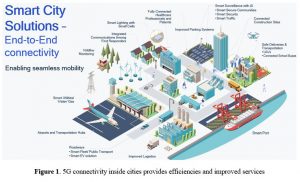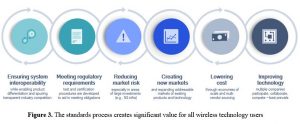How 5G is making cities safer, smarter, and more efficient
It’s a scenario we’ve all experienced: an ambulance with a blaring siren racing against time to get a person in medical distress to a hospital through traffic.
What we don’t see is 5G connectivity enabling paramedics to communicate with hospital staff via video conference and coordinate care in real-time before arriving at the emergency room. 5G allows for real-time transmission of patient vital statistics and status via video, informing emergency-room preparation to appropriately service the incoming patient. It also supports applications that provide improved navigation data and ambulance-to-streetlight communications that ensure a green-lit roadway path, so the ambulance can arrive as quickly as possible.
5G is the fifth generation of cellular technology supporting higher data rates and lower latency, or network response time. 5G achieves these improvements in smartphone-sized (and smaller) form factors while using spectrum more efficiently and drawing less power to extend precious battery life. The highly flexible 5G interface supports a broad and ever-expanding collection of communications use cases: from low data rate applications, such as those used for remote medical monitoring of a patient’s vitals, to unmanned airborne vehicles (“UAVs” or drones) that livestream Ultra High Definition (“Ultra HD”) video to provide a third eye to public-safety officials during emergencies.
Many U.S. cities are working with mobile carriers to deploy the advanced capabilities of 5G to upgrade public safety and other government services, improve the day-to-day lives of citizens and their workplaces, and attract new businesses. Worldwide, more than 225 operators have deployed 5G technology, and they will soon begin deploying the second wave of 5G technology—5G Advanced. 5G Advanced builds on existing 5G technology to provide richer connections between everyone and everything around us. 5G delivers enhanced mobile broadband right now, and 5G Advanced will expand the technology into new use cases and verticals requiring high performance levels.
5G delivers advanced mobility to cities, including their citizens and businesses
As we are in the early 5G deployment stages, there are many critical new applications that 5G will support in education, healthcare, public safety, transportation, smart buildings, and smart infrastructure over the coming years.
For example, a city blanketed with reliable 5G coverage attracts and supports businesses with mobile workers that need to connect at home, in the office, at a local café, and while in transit. Workers need to maintain reliable communications connectivity as they travel to their offices, attend business meetings outside the office, pick up children at school, and attend events in the evening, and 5G is the common connectivity thread.
Figure 1 below depicts smart-city solutions that 5G is making possible today. On the simple side, 5G can carry alerts of available parking spots and allow connected sanitation bins to alert collectors when they need to be cleared. More advanced applications include aiding public-safety operations with AI-enabled security cameras that monitor crowd safety in city centers, transportation hubs, and public venues. 5G makes transportation fleets and manufacturing processes more efficient through real-time asset monitoring, predictive maintenance and inventory management via communications with mobile robotics and IoT sensors, as well as augmented and virtual reality (“AR/VR”) tools.

5G also facilitates better management of utilities, infrastructure, and buildings. The technology’s high throughput and low latency enables real-time and remote energy production/consumption monitoring and maintenance, including efficient management of traditional and renewable energy. 5G supports smart buildings with real-time communication of advanced monitoring/management of energy consumption through elements like smart meters and HVAC control. Operation on 5G’s wider bandwidths than earlier generations of wireless technology greatly improves position accuracy for countless applications, such as locating 911 emergency callers.
5G Advanced’s functionality is expected to encourage the development of new and enhanced devices, services, and applications, including AR/VR tools for citizens and businesses. More than a buzzword, the metaverse is a geographically aware internet that leverages AR/VR tools for personalized digital experiences that span the physical and virtual worlds. These tools will improve citizen safety through AI-fueled security tools, enhance navigation and mapping for drivers, as well as improve factory automation, business and social interactions, and other applications.
5G technology is bringing a new era of public safety response capabilities to cities
With 5G widely deployed, a city will be better equipped to handle public-safety emergencies. The initial minutes of an emergency are critical for first responders, so they must have relevant information as soon as possible about the situation to make informed decisions.
Supported by 5G connectivity, high-resolution sensors and cameras—including those integrated into unmanned aerial vehicles (UAVs)—can provide real-time on-the-ground and aerial views of the scene of an emergency. Operators can use UAVs with precision navigation and Ultra HD cameras to assess the environment and deliver supplies to first responders and others in need.
As AR/VR is incorporated into first-responder training, immersive simulations will improve training and situational awareness, which ultimately should enhance decision-making processes. AR/VR is being used today for medical training and can be used for public-safety purposes. For instance, the Johns Hopkins School of Nursing uses VR to train students to make crucial, time-sensitive decisions when triaging severely distressed patients.
The full 5G experience uses new spectrum bands to support new applications
The full 5G experience utilizes all available frequency bands, including spectrum below 7 GHz and high bands above 24 GHz in the millimeter-wave (mmWave) range. Concurrent mobile operations in these airwaves support highly reliable 5G services.
Low-band spectrum below 1 GHz propagates well—allowing signals to travel farther—but the channel capacity is limited. Signals sent via mid-band spectrum between 1 and 7 GHz do not travel as far as low-band spectrum, but it allows for higher data speeds. And mmWave band signal propagation is less than that of mid-band spectrum, but the available bandwidth is much greater than is generally available in bands below 7 GHz. Today’s devices use multiple frequency bands simultaneously to take advantage of these spectral characteristics to improve service quality and performance.

Many wireless technologies that need high-resolution, real-time video for public-safety and crowd-security purposes can use the mmWave bands, because they support high-throughput, low-latency connectivity. When the Federal Communications Commission (“FCC”) opened the mmWave spectrum bands for mobile applications in July 2016, no smartphone supported mobile operations in the mmWave bands. Today, thanks to many 5G technology advances, all leading smartphones support mmWave mobile communications and can receive signals delivered at multi-gigabit-per-second speeds.
The wide channel bandwidths available in the mmWave bands will become increasingly important to support the data demands of Ultra HD video streaming, AR/VR, and other emerging applications. In addition, the massive leaps in mobile data usage since 5G launched several years ago will require the use of mmWave spectrum to serve future demands, particularly in densely populated areas. Combined with the growing number of users, these areas are difficult to serve effectively using existing low-band and mid-band spectrum allocations.
The wide channels available in the mmWave bands let mobile operators support many more connections with greater peak data rates for individual users. Mobile carriers are deploying 5G mobile mmWave connectivity in areas that experience heavy foot traffic and can get quite crowded at times throughout the day, such as malls, train stations, airport terminals, busy shopping streets, and venues hosting sporting events and concerts. Maintaining reliable communications connectivity in these settings is particularly important for public safety purposes, and wide 5G mmWave channels can support many more individuals receiving instructions that can ensure their safety in the event of a local emergency.
5G Fixed Wireless Access (FWA) systems provide fiber-like speeds at lower cost and in less time
5G is the first mobile technology generation that provides genuine competition to cable and other wireline service providers. 5G FWA systems can be deployed less expensively and more quickly than wireline deployments and they can wirelessly stream multi-gigabit connectivity to homes, businesses, schools, and other locations traditionally served by fiber-optic or coaxial cable-based systems.
FWA is a fast-growing broadband solution. In 2022, fixed wireless subscribers grew by more than 70% across all providers. Today, millions of homes and businesses have access to FWA-fed gigabit connectivity.
Cities have an opportunity to take advantage of substantial federal grant opportunities to improve services in unserved and underserved communities. For instance, the Broadband Equity, Access, and Deployment (“BEAD”) Program—authorized by the 2021 Bipartisan Infrastructure Law—allocates about $42 billion for U.S. states, territories, and the District of Columbia to provide affordable, high-speed broadband connectivity in unserved and underserved areas, as well as to community anchor institutions. FWA systems deployed using mmWave spectrum could cost effectively provide low latency, multi-gigabit-per-second connectivity to fulfill this vital goal, while also supporting multi-gigabit mobile connectivity to cellular devices within range of mmWave connectivity.
5G’s success is based firmly on a robust standards ecosystem
The mobile-communications industry is based on technology standards developed in industry-led groups, such as the Third Generation Partnership Project (3GPP) that drives global cellular standards, ensuring inter-vendor system interoperability and encouraging open and fair industry competition.
The standards process brings many benefits to the mobile ecosystem. With 5G, standards helped the existing mobile cellular ecosystem leverage existing products and technologies to expand into new industries. For the past several years, 3GPP has been working to extend the reach of cellular technology into other verticals, like automotive, unmanned aircraft systems (“UAS”) and industrial automation.

Moreover, the benefits of standardization include enabling interoperability, ensuring regulatory compliance, and reducing the market risk for equipment makers—particularly in technology areas requiring massive investments, such as new generations of mobile communications infrastructure equipment and mobile devices.
And by motivating multiple companies to participate, collaborate and advocate for their technological approaches to be integrated into standards, the 3GPP process helps improve the underlying technology, as the best approach often becomes part of the standard.
5G will continue to serve an increasingly important role in our connected lives, enabling new applications and use cases that improve business processes, education, energy production and consumption, healthcare, manufacturing, transportation, and public safety.
John Kuzin and Leslie Barnes are with Qualcomm Incorporated and represent the company before the FCC and other federal agencies. They are based in Washington DC and can be reached at [email protected] and [email protected].
Qualcomm participates in about 200 global standards and industry associations, because the company is focused on making the benefits of mobile communications available to improve everyone’s lives, create efficiencies, lower costs, and enable the development of new services and applications.


















